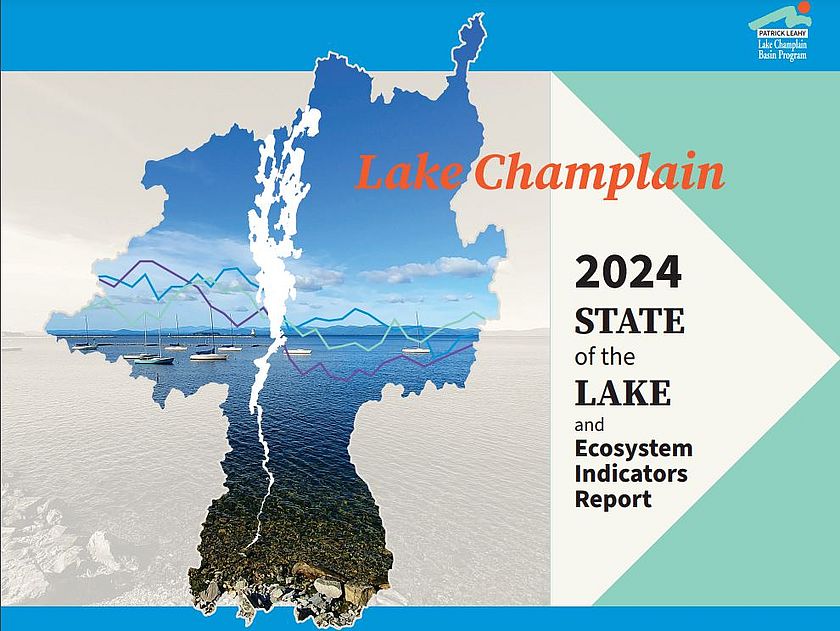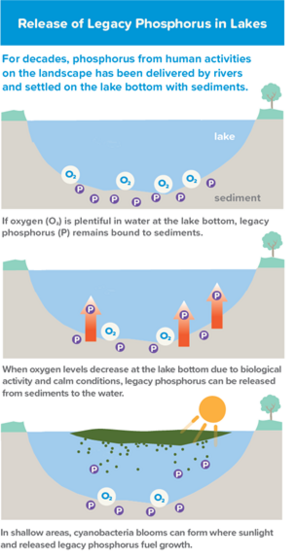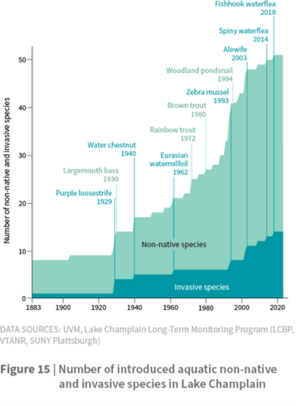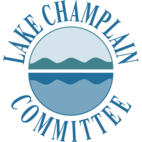What's the State of the Lake?
Every three years, the Lake Champlain Basin Program -- the entity that coordinates and helps fund implementation of the Lake Champlain restoration and management plan in partnership with New York, Vermont, and Quebec government agencies -- publishes a State of the Lake (SOTL) report. The 2024 edition released in June of this year provides a health check up on the four goals of clean water, healthy ecosystems, informed and involved public, and thriving communities. It includes a “scorecard” showing data trends on phosphorus, cyanobacteria blooms, and the introduction of new invasive species. The SOTL report uses easy-to-understand graphics and maps to illustrate complex issues and is publicly available via the Lake Champlain Basin Program’s (LCBP’s) website at lcbp.org. What follows is a brief tour of the contents and some take-aways from the 36-page report.


Clean water
On an average summer day, three billion gallons of water is conveyed to Lake Champlain by the rivers in its basin. All this water carries an imprint of the landscape: nutrients, organic material, toxic contaminants, and other pollutants. SOTL looks at “clean water” from multiple angles: drinkability, swimmability, and fishability. The report also discusses pathogen contamination, cyanobacteria and their associated toxins, nitrogen and phosphorus conveyance, contaminants such as microplastics and pesticides, and the impacts of recent floods.
The 2024 report includes some positive findings: mercury concentrations in fish have been decreasing since the 1990s, beaches on Lake Champlain are safe for swimming much of the time, and cyanotoxins are rarely detected in both bloom and non-bloom conditions. But there’s also lots of worrisome news: certain areas of the lake experienced a relatively higher incidence of cyanobacteria blooms in 2023 than previous years, since 1990 none of Lake Champlain’s segments have maintained annual phosphorus levels below the limits necessary to protect ecosystem health and other parameters, and heavy road salt usage throughout the basin is driving rising chloride levels.
Climate change is the specter that looms over all water quality issues discussed in the SOTL report. Modeling suggests that the surface of Lake Champlain will freeze over just once per decade by 2050 and that future winters will be shorter and summers hotter with greater water quality impacts. Warmer water triggers the release of legacy phosphorus, and both help cyanobacteria blooms flourish. Warmer air can hold more water, which drives heavy precipitation and floods. Since this report came out prior to the July 2024 floods, the flooding information it provides focuses on the July 2023 floods. Notably, in the seven-day period that began on July 10 2023, over 300 metric tons of phosphorus were delivered to Lake Champlain—roughly half of the annual targeted load. The flooding and stormwater runoff triggered wastewater treatment failures and combined sewer overflows and high lake levels from the storms led to more erosion from shoreline scouring. Protecting and restoring wetlands and other natural features that absorb floodwaters and store carbon is one key approach to build climate resiliency and mitigate the results of greater and more frequent storm events. It makes sense ecologically and economically: UVM scientists estimated that the largely protected Otter Creek floodplain near Middlebury VT saves the town up to $450,000 per year in flood damages.

Healthy ecosystems
There’s also mixed news on Lake Champlain’s ecosystem health. There have been no new introduction of aquatic invasive species (AIS) to the lake since 2018; however, there are new invasives at our doorstep such as the round goby (Neogobius melanostomus), which have been detected moving upstream in the Hudson River to the Champlain Canal and are also present in the St. Lawrence and Richelieu Rivers to the north. AIS continue to spread in Lake Champlain—while areas that have established populations of the invasive European water chestnut (Trapa natans) are effectively managed by hand and mechanical harvesting, new populations have been detected in the last few years in Dead Creek in Plattsburgh NY and Gander Bay just outside the Missisquoi National Wildlife Refuge in VT. Invasive species are not the only threat to healthy ecosystems: habitats are fragmented with culverts, which often act as a barrier to native aquatic organism passage, and climate change—arguably the greatest threat facing Lake Champlain—drives the spread of invasive species such as Japanese Knotweed from increased flooding and riverbank erosion, while warmer waters threaten the health of cold-water fish species.
Thriving communities
The 2024 SOTL report takes an interdisciplinary approach to assessing the overall health of Lake Champlain by devoting sections of the publication to community engagement.A 2021 public awareness survey conducted for LCBP by LCC, Lake Champlain Sea Grant, and UVM Extension found that 97% of respondents believe healthy waterways are a critical part of thriving communities but far fewer knew how to find information on water quality protection especially in some underserved regions. There are several efforts underway to provide more opportunities for civic engagement and reduce barriers to access: the Lake Champlain Maritime Museum in Vergennes VT eliminated ticket fees in 2021 and saw a 30% increase in visitors compared to 2019; the Community Sailing Center in Burlington VT recently started offering free Floating Classroom programs for students in underserved communities; and the Lake Champlain Basin Program and partners host fishing education workshops with free fishing licenses for new American and economically disadvantaged participants.

Informed and involved public
The “informed and involved public” section of SOTL highlights a disconnect between people’s knowledge and concern about lake health and their willingness to act. The 2021 public awareness survey found that 92% of respondents believe their actions affect water quality, but only 10% of respondents engaged in four or more stewardship actions. The report noted that outreach declined substantially during the COVID-19 pandemic but programs to educate and involve community members are rebounding. LCC is a partner on the Champlain Basin Education Initiative, which after several years of hiatus during the pandemic, just hosted the Watershed for Every Classroom program for educators across the basin.
The health of Lake Champlain reflects our values—what we protect, restore, and invest in. There are many actions individuals can take to help protect and improve water quality from installing rain barrels and avoiding using phosphorus-based fertilizers to planting native vegetation along shorelines and becoming a community science volunteer. LCC has some great opportunities for people to participate in lake stewardship including joining our Clean Lake Environmental Action Network (CLEAN), to help advocate for clean, accessible water. Complete LCC’s Volunteer Response Form if you’re able to play a more active role.
The full 2024 State of the Lake Report is available for free online on the Lake Champlain Basin Program's website.
